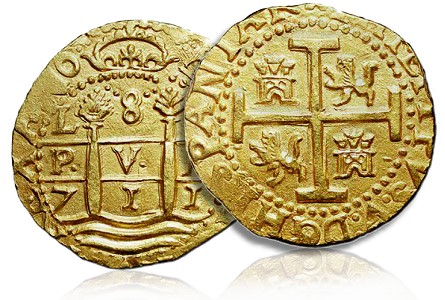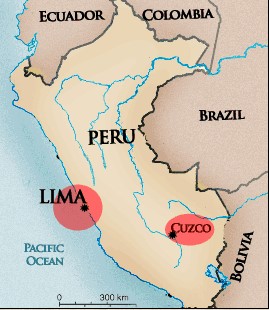By Daniel Frank Sedwick – Sedwickcoins.com ……
Serious coin collectors generally concentrate on perfection: the more perfect the coin, the more desirable and valuable it is. As a result many of them shy away from cobs, which, being hand-struck on hand-cut flans, are understandably less than perfect. The gold cobs of Lima and Cuzco, Peru, however, are the exception, and their beautiful design and execution are finally getting the attention they deserve from an increasing cadre of new collectors of means all over the world, with still many decades to go before these coins hit the six-figure levels of comparable US coins.[1]
 For starters, the Peruvian gold-cob series is eminently collectible, with nearly all the years of 1696-1750 more or less available with time and patience, at least in the 8 escudos, as the smaller gold coins are less common overall (note also that we are excluding the unauthorized issues of 1659, which are somewhat conjectural). That is not to say that Peruvian gold cobs are common; in fact the opposite is the case, as generally these coins were shipped to Spain and melted.[2] Not surprisingly, much of the market supply of these coins comes from several different shipwreck finds, particularly the 1715 Fleet[3] but also the Loosdrecht (1719), the 1733 Fleet and the Luz (1752).[4] Type-collectors enjoy the fact that Peruvian gold cobs cover four reigns; Charles II, Philip V, Louis I and Ferdinand VI, while numerous die-varieties (overdates, legend lettering and interior ornamentation) present challenges for advanced collectors. Perhaps most important, the gold cobs of Peru have a unique design, which was not made at any other Old World or New World Spanish mint.
For starters, the Peruvian gold-cob series is eminently collectible, with nearly all the years of 1696-1750 more or less available with time and patience, at least in the 8 escudos, as the smaller gold coins are less common overall (note also that we are excluding the unauthorized issues of 1659, which are somewhat conjectural). That is not to say that Peruvian gold cobs are common; in fact the opposite is the case, as generally these coins were shipped to Spain and melted.[2] Not surprisingly, much of the market supply of these coins comes from several different shipwreck finds, particularly the 1715 Fleet[3] but also the Loosdrecht (1719), the 1733 Fleet and the Luz (1752).[4] Type-collectors enjoy the fact that Peruvian gold cobs cover four reigns; Charles II, Philip V, Louis I and Ferdinand VI, while numerous die-varieties (overdates, legend lettering and interior ornamentation) present challenges for advanced collectors. Perhaps most important, the gold cobs of Peru have a unique design, which was not made at any other Old World or New World Spanish mint.
This masterful design reflects the fact that silver cobs in Peru were struck for well over 100 years before gold cobs, through periods of mint closure, fraud, scandal and redesign. By the time the Lima mint had begun to strike gold in 1696, it had already been decided that one side of each coin should show castles and lions within a cross on the obverse and a tic-tac-toe design consisting of mintmark, assayer, date and the PLVS VLTRA motto on the reverse. (The simpler 1 escudo bears only mintmark-assayer flanking and date below a castle on obverse and plain cross on reverse.) While the Peruvian engravers never achieved total consistency with the legends (also the quality of details declined steadily over the years), the basic inner design NEVER changed except for ornamentation. Why mess with success?
But it is the execution of this design that is remarkable in Peruvian gold cobs, for practically every specimen is well centered, with clear date and assayer and mintmark and usually with most of the characters in the legends at least partially visible, on a round flan of uniform thickness and consistent weight (albeit about an eighth of a gram below the standard of 27.064 grams). Compare this to the odd-shaped and haphazardly struck gold cobs of Mexico and Colombia, which seldom show clear dates, mintmarks and assayers. Also, there are no specially produced, six-figure Peruvian gold-cob “royals” (round presentation pieces) to relegate the rest of the coins to second class (although a few early issues are so round and broad as to be considered “pseudo-Royals” by some researchers).
Many helpful reference books and articles are available to assist the advanced collector (see end of article). With this article, though, we present an up-to-date summary of the 8-escudos dates, showing known varieties and relative rarities, followed by only general date-ranges by king and assayer for the smaller denominations, as these are far less available than the 8 escudos. The letter after each 8-escudos date is the assayer initial: note that some dates were struck under two different assayers, and the assayers for a given date are not necessarily the same for every denomination.
Like all gold cobs, these coins hold their values well above bullion levels, but they are never obscenely costly. The cheapest 8 escudos are available in the $5000-$7500 range; expect to pay $15,000-$25,000 or more for the best specimens in terms of not only rarity but also quality of strike (mostly centering, but also clarity of second date and other parts of the legends) and condition (grade and absence of damage.[5] Salvaged specimens bear no stigma at all in terms of grading, as the third-party grading companies (PCGS, NGC and the like) give them the same numeric grades as similarly uncirculated coins, with perhaps some emphasis on quality of strike (early die state, for example) to get the higher numbers.[6] Typical cob hazards like double-striking, edge-cracks or bubbles in the metal are rarely an issue with Peruvian gold cobs. The only quality issue to watch out for is the fact that so many Peruvian gold cobs have ended up in jewelry mountings, for these coins tend to be victims of their own beauty!
Note: All the gold cobs pictured in this article have been sold at auction or privately by Daniel Frank Sedwick, LLC.
 [1] Note, after all, that even the early US goldsmith Ephraim Brasher saw fit to imitate the Peruvian cob 8 escudos among his famous “Brasher doubloons” in the 1780s.
[1] Note, after all, that even the early US goldsmith Ephraim Brasher saw fit to imitate the Peruvian cob 8 escudos among his famous “Brasher doubloons” in the 1780s.
[2] A telling statistic is the fact that the State of Florida collection has ten times as many Mexican gold cobs as Peruvian.
[3] Quantities of Peruvian gold cobs from the 1715 Fleet were found in the 1960s and in 1988, but not since then.
[4] Also the Whydah (1717), but the coins from that wreck are not available for sale. There is also a ca.-1700 wreck off Ecuador (possibly the Aguila Volante of 1701) that may have yielded some Cuzco gold cobs. The one wreck that will surely alter early Peruvian gold-cob populations, if it can ever be salvaged, is the San Jose of 1708 in deep water off Cartagena, Colombia.
[5] Note this is about three to five times what this quality cost 20 years ago. Quoting Frank Sedwick from a talk he gave in 1989, “we have a long way to go in the gold.”
[6] Third-party grading of cobs is actually a controversial matter, because a numeric indication of circulation wear hardly describes the overall quality of a cob so much as the strike and die state, whereas making up a “net grade” from these factors is illogical as well against numeric grades for other types of coins. For ancient coins the grading companies have experimented with multi-level assessments, giving 1-5 numeric grades for strike and surfaces in addition to the overall grade; but while this is more accurate, unfortunately it hinders comparative analysis (which is better, for example, better strike or better surfaces?). Just as no two cobs are completely alike, no two collectors will ever agree which cobs are the best.
Further reading:
– Calica, X. Numismatica espanola / Catalogo de todas las monedas emitidas desde los Reyes Catalicos hasta Juan Carlos I, 1474 a 2001 (Barcelona, 2008).
– Craig, Alan K. Spanish Colonial Coins in the Florida Collection (Gainesville, FL, 2000).
– de la Puente Jere, Pedro. La Amonedacien en Oro de las Cecas de Lima, Cuzco y Potose, 1659-1979 (Lima, 1994).
– Lopez-Chaves y Sanchez, Leopoldo (with Jose de Yriarte y Oliva). Catalogo General de la Onza (Madrid, 1968); Catalogo de la Onza Espaola (1961); Catalogo de la Media Onza (1962); and Catalogo del Dobl en de a Dos Escudos (1964).
– Sedwick, Daniel and Frank. The Practical Book of Cobs, 4th edition (Winter Park, FL, 2007).
– Sedwick, Frank. “The Gold Cobs of Peru,” presentation and offprint article in the Coinage of the Americas Conference at the American Numismatic Society (New York, 1988).
– Tauler Fesser, Rafael. Oro Macuquino / Catalogo Imperio Espanol, 1474 a 1756 (Madrid, 2011).





Wonderful article. You can always visit http://www.goldcoin.net for more information on Gold Coins.
How much is a1736 gold coin worth today